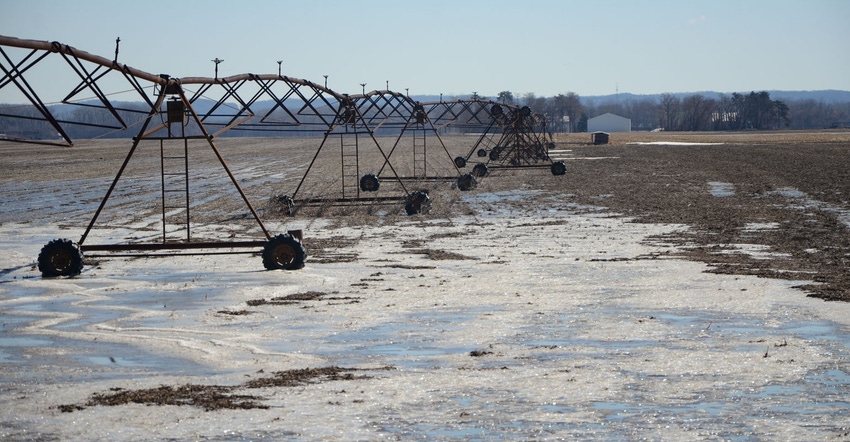
With more than a million acres of agricultural land flooded in the Midwest this spring, irrigators will be dealing with center pivots affected by flooding.
Steve Melvin, Nebraska Extension irrigated cropping systems educator, notes if water has submerged any of the pivot's components, they need to be inspected for damage — even if they were only underwater for a brief time.
When it comes to center pivots, there are a few components growers can inspect themselves — such as the center drive unit and gearboxes.
"If water reached the tower drive motors and gearboxes, the motors should be taken apart to make sure they're dried out well before running the pivot," Melvin says.
"On hydraulic drive pivots, the motors on the machine aren't really a concern," he adds. "The concern is the oil pump. If the water got over the reservoir where the pump is, they need to make sure the water didn't get into their oil reservoir."
Don't try to start the electric motor until it has completely dried out. The motor might need to be removed and disassembled, so it's also recommended to check with the pump company before starting the motor.
Once dry, drain and replace the oil. It's also a good idea to grease the motor bearings, and add grease until old grease is expelled.
If the internal combustion engine was submerged, major servicing will be needed — and that may involve a complete rebuild. This includes draining and replacing the oil, pulling injectors or spark plugs to make sure no water is in the cylinders before starting the engine, and replacing all filters.
Leave it to professionals
However, when dealing with certain electrical components, it's best to let a professional handle it.
"I get nervous when growers mess with electrical components on a center pivot,” Melvin says. “You've got to make sure the power is turned off of the pivot before you mess with it, and technically, you should have a padlock on the off switch to make sure someone doesn't switch it back on again. There are a number of safety procedures that are tough to cover. If you make a mistake with 480 volts of electricity, you don't get a second chance."
These high-voltage situations include any place where water reached tower boxes and pivot panels — both of which, while potentially salvageable, are best left to the pivot dealer to handle, Melvin says.
Growers also should check the wiring on the grounding system that supplies electricity from the meter pole to the pivot to make sure it wasn't damaged by debris, ice or water.
"There can be ice, logs and other things that floated by,” Melvin says. “So, it's important to make sure the cables or insulation didn't get damaged. If a big chunk of ice hit it and pulled a wire loose, it needs to be fixed. If anything looks suspicious, he'd better call an electrician."
Damaged cause by debris and floodwater could have caused additional electrical safety hazards, and it's recommended to let your local dealer handle inspections or repairs surrounding the electrical components. Pivot technicians also may notice additional damage or problem areas overlooked by the grower.
Don't forget furrow irrigation
Of course, it won't just be center pivots that are affected. Furrow-irrigated fields and wells also may have been affected by the 2019 flood — and there are some concerns specific to furrow irrigation in the aftermath of this year's weather.
"Some irrigators might not have put an endcap over the well when they removed the pipe last fall, which could have led to a lot of water, gravel, rocks and debris going down into that well," Melvin says. "I would make sure the pumps turn freely before putting power to them."
There's also the issue of how the water will flow in a furrow-irrigated field after erosion or sand and silt deposition.
"Sometimes people overlook furrow irrigation, but along the river, there is a lot of furrow irrigation, because field shapes make the economics of pivots unfavorable," Melvin says. "Many of those fields are flat to begin with, and if you've got 6 inches of silt on the bottom of the field, or even a couple inches, the water may not move across the field the same as before or may not run through at all."
About the Author(s)
You May Also Like






